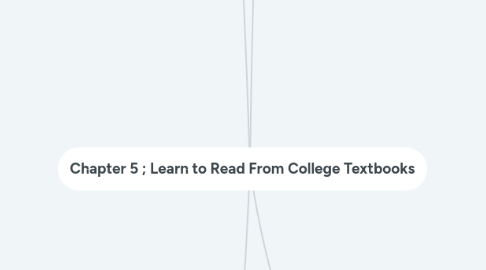
1. 5.1 ; A Plan For Active Reading
1.1. Participating in reading by using strategies.
1.2. Previewing.
1.2.1. The first step in active reading.
1.2.2. Looking at assigned reading before tackling the content.
1.2.2.1. Read title.
1.2.2.2. Learning objectives.
1.2.2.3. Read the summary.
1.2.2.4. Skim.
1.2.2.4.1. For headings.
1.2.2.4.2. For terms.
1.2.2.4.3. For tables.
1.2.2.5. Note page count.
1.2.3. Mapping.
1.2.3.1. Wheel structure.
1.2.3.2. Branching system.
1.2.4. Outlining and Listing.
1.2.4.1. No full sentences.
1.2.4.2. Use chunking.
1.3. Marking.
1.3.1. Read at least twice before marking.
1.3.2. Think before you mark.
1.3.3. Underline, highlight, circle, and annotate.
1.3.4. Take notes too.
1.3.4.1. Create flashcards.
1.3.4.2. Create a map.
1.4. Reading With Concentration.
1.4.1. Quite place.
1.4.2. Unplug.
1.4.3. Take breaks.
1.4.4. Actively engage.
1.4.5. Organize.
1.5. Reviewing.
1.5.1. Looking through the assigned reading again.
1.5.2. Recite aloud.
1.5.3. Tick items off with fingers.
1.5.4. Put notes up around living space.
2. Tech Tip ; E-Book
2.1. Pros.
2.1.1. Portable.
2.1.2. Organizational.
2.1.3. Auditory learners get audio books.
2.1.4. Linked to dictionaries.
2.1.5. Shareable/searchable.
2.2. Cons.
2.2.1. Expensive.
2.2.2. Breakable.
2.2.3. Harder to understand/work.
2.3. Recommend use of . . .
2.3.1. iPad.
2.3.2. Kindle.
2.3.3. Nook.
2.3.4. Kobo Touch.
3. 5.2 ; Strategies For Reading Textbooks
3.1. Math.
3.1.1. Lots of symbols, few words.
3.1.2. Sample problems.
3.1.3. Practice regularly.
3.2. Science.
3.2.1. Become familiar with textbook.
3.2.1.1. Glossary - terms and definitions.
3.2.1.2. Appendix - supplemental materials.
3.2.2. Organization.
3.2.3. Outline format.
3.2.4. Skim chapters before you read.
3.3. Socials and Humanitites.
3.3.1. Special terms for particular study.
3.3.2. Reference to primary sources.
3.3.3. Identify central themes.
3.4. Supplementary Material.
3.4.1. Original source that gives more detail.
3.4.1.1. Research papers.
3.4.1.2. Journal articles.
3.4.2. Further understanding of material.
3.4.3. Abstract - summary of major findings.
4. 5.3 ; Improve Your Reading
4.1. Be flexible and adjust.
4.1.1. Reading style.
4.1.2. Reading time.
4.2. Monitor reading.
4.2.1. Recite material out loud.
4.2.2. Identify questions.
4.3. Develop vocabulary.
4.3.1. Consider words parts.
4.3.1.1. Suffixes.
4.3.1.2. Prefixes.
4.3.2. Use glossary and dictionary.
